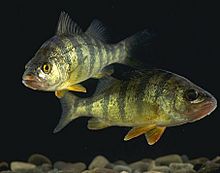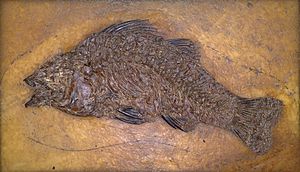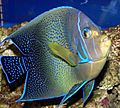Perciformes facts for kids
Quick facts for kids Perciformes |
|
|---|---|
 |
|
| Yellow perch (Perca flavescens) | |
| Scientific classification | |
| Kingdom: | |
| Phylum: | |
| Class: | |
| Superorder: |
Acanthopterygii
|
| Order: |
Perciformes
|
The Perciformes are a huge group of fish! They are the biggest group of vertebrates (animals with backbones) and make up about 40% of all bony fish.
Their name, Perciformes, means 'perch-like', because many of them look like a perch. These fish are part of the ray-finned fish family. There are over 7,000 different species of Perciformes, and you can find them in almost every water environment on Earth.
This group has the widest range of sizes among all vertebrates. Some are tiny, like the 7 mm Schindleria brevipinguis. Others are giant, like the 5-meter-long Makaira species (which includes swordfish and marlin). Perciformes first appeared and became diverse during the Upper Cretaceous period.
Many well-known fish are part of this group. These include angelfish, barracuda, bass, blenny, cichlids, damselfish, filefish, goby, grouper, remora, swordfish, mackerel, pufferfish, tilefish, tuna, whiting, and, of course, perch.
What Makes Perciformes Special?
Perciformes have some special features that help scientists identify them. Their dorsal (top) and anal (bottom) fins are usually split. The front part of these fins has sharp spines, while the back part has soft rays. These two parts can be partly or fully separated.
Their pelvic fins are also unique. They usually have one spine and up to five soft rays. These fins are often located far forward, either under the chin or under the belly of the fish. Most Perciformes have ctenoid scales, which means they have rough, comb-like edges.
How Scientists Study Perciformes
Scientists group fish like Perciformes to understand how they are related. The Perciformes group is very large and complex. Because of this, scientists are always studying them. They use different methods, like looking at the fish's body parts (morphology) and studying their DNA.
Sometimes, these studies show that the way fish are grouped might need to change. This is because some groups might not include all the descendants of a common ancestor. This means that the Perciformes group, and other fish groups, might be updated in the future as scientists learn more.
Images for kids
-
Perciformes display at the National Museum of Natural History.
See also
 In Spanish: Perciformes para niños
In Spanish: Perciformes para niños




